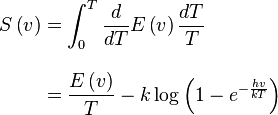Elastic Solids
See: Einstein solid and Debye model
In any solid at any temperature, the primary particles (e.g. atoms or molecules) are not stationary, but rather vibrate about mean positions. In insulators the capacity of the solid to store thermal energy is due almost entirely to these vibrations. Many physical properties of the solid (e.g. modulus of elasticity) can be predicted given knowledge of the frequencies with which the particles vibrate. The simplest assumption (by Einstein) is that all the particles oscillate about their mean positions with the same natural frequency ν. This is equivalent to the assumption that all atoms vibrate independently with a frequency ν. Einstein also assumed that the allowed energy states of these oscillations are harmonics, or integral multiples of hν. The spectrum of waveforms can be described mathematically using a Fourier series of sinusoidal density fluctuations (or thermal phonons).
Debye subsequently recognized that each oscillator is intimately coupled to its neighboring oscillators at all times. Thus, by replacing Einstein's identical uncoupled oscillators with the same number of coupled oscillators, Debye correlated the elastic vibrations of a one-dimensional solid with the number of mathematically special modes of vibration of a stretched string (see figure). The pure tone of lowest pitch or frequency is referred to as the fundamental and the multiples of that frequency are called its harmonic overtones. He assigned to one of the oscillators the frequency of the fundamental vibration of the whole block of solid. He assigned to the remaining oscillators the frequencies of the harmonics of that fundamental, with the highest of all these frequencies being limited by the motion of the smallest primary unit.
The normal modes of vibration of a crystal are in general superpositions of many overtones, each with an appropriate amplitude and phase. Longer wavelength (low frequency) phonons are exactly those acoustical vibrations which are considered in the theory of sound. Both longitudinal and transverse waves can be propagated through a solid, while, in general, only longitudinal waves are supported by fluids.
In the longitudinal mode, the displacement of particles from their positions of equilibrium coincides with the propagation direction of the wave. Mechanical longitudinal waves have been also referred to as compression waves. For transverse modes, individual particles move perpendicular to the propagation of the wave.
According to quantum theory, the mean energy of a normal vibrational mode of a crystalline solid with characteristic frequency υ is:
The term (1/2)hυ represents the "zero-point energy", or the energy which an oscillator will have at absolute zero. E (ν ) tends to the classic value kT at high temperatures
The entropy per normal mode is:
The free energy is:
which, for kT >> hν, tends to:
In order to calculate the internal energy and the specific heat, we must know the number of normal vibrational modes a frequency between the values ν and ν + dν. Allow this number to be f (ν)dν. Since the total number of normal modes is 3N, the function f (ν) is given by:
The integration is performed over all frequencies of the crystal. Then the internal energy U will be given by:
Read more about this topic: Normal Mode
Famous quotes containing the word elastic:
“The change from storm and winter to serene and mild weather, from dark and sluggish hours to bright and elastic ones, is a memorable crisis which all things proclaim. It is seemingly instantaneous at last.”
—Henry David Thoreau (1817–1862)
